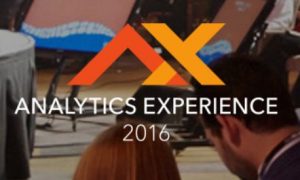 Analytics Experience 2016 featured more than 100 breakout sessions and talks covering numerous topics in big data. You can watch many of those talks from our Analytics Experience 2016 video portal, where select keynote and session talks are archived. To give you a taste of the content you'll find there, here’s a look at two of those sessions from two very different companies – Dow Jones and UnitedHealthcare – which transformed their data strategies with SAS®. For Dow Jones, the answer was the cloud. For UnitedHealthcare, Hadoop. When it comes to data problems, there’s no one-size-fits-all solution. The beauty of SAS is that it’s adaptable to all different sorts of problems.
Analytics Experience 2016 featured more than 100 breakout sessions and talks covering numerous topics in big data. You can watch many of those talks from our Analytics Experience 2016 video portal, where select keynote and session talks are archived. To give you a taste of the content you'll find there, here’s a look at two of those sessions from two very different companies – Dow Jones and UnitedHealthcare – which transformed their data strategies with SAS®. For Dow Jones, the answer was the cloud. For UnitedHealthcare, Hadoop. When it comes to data problems, there’s no one-size-fits-all solution. The beauty of SAS is that it’s adaptable to all different sorts of problems.
Building practical analytics at The Wall Street Journal
In many ways, Dow Jones, which publishes The Wall Street Journal, MarketWatch and Barron’s, is a traditional publisher trying to transition to a new media landscape. In response to a shift in how its customers consume news today, the company has been forced to make its own changes. Jeff Parkinson, Vice President of Customer Operations at Dow Jones, spoke during an Analytics Experience breakout session about how the business has transformed the way it uses data to understand and support its customer base.
Working from legacy systems, Dow Jones faced enormous challenges, with multiple analytics teams working on the same analysis. “To get a standard data model out there – how many subscribers we had in a particular region – would sometimes take us weeks,” said Parkinson.
Parkinson knew the company needed a major change, but he didn’t want to lose the code that his team had already written in SAS®. After consulting with their SAS Account Executive, the company decided to supercharge their program with SAS/ACCESS® Interface to Amazon Redshift on AWS.
With smart leadership, and a team that was “MacGyver-esque,” the transition was smoother than they expected. Dow Jones’ existing SAS code was so polished that it easily moved to the cloud via Redshift, and the team was able to finish the project in less than three months. Today, Dow Jones now has a centralized data infrastructure, which is being carefully analyzed and audited by data quality teams.
The story for Dow Jones is just beginning, but Parkinson is extremely optimistic about the future. Their focus is to put analytics to work and uncover more about how Dow Jones is working to maximize, protect and secure customer data.
Watch the complete session here.
Transform your analytics ecosystem with Hadoop
For those attending Analytics Experience who were seeking information about adding Hadoop to their existing SAS® Analytics capabilities, Ravi Shanbhag had some great advice and practical tips to apply, because he’s lived through it.
As UnitedHealthcare’s Director of Data Science, Solutions and Strategy, Shanbhag played a key role in helping to take the company from a legacy SAS environment to a grid-based environment in order to advance the company’s analytics ecosystem.
“We had to go to a grid-based environment in order to scale up,” said Shanbhag. “It was a massive addition to our computation needs.”
With the move, 100 users became 700-plus users; 8,000 processes a week became 90,000 processes; and 8 TB of data turned into more than 150 TB. And yet, there was still a problem. Unifying so many diverse groups on the grid led to a growth explosion. The UnitedHealthcare team realized they had to add Hadoop into the mix if they wanted to keep up.
“We wanted to use Hadoop for more than a place to store data,” said Shanbhag. “We wanted a 360-degree view of our data. With Hadoop, we got a superset of our data and a single source of truth for all analytics.”
UnitedHealthcare’s Hadoop data lake – fed by a variety of sources, including claims, revenue, clinical, financial and call center – resides on top of SAS. “The SAS grid is independent from the Hadoop cluster, but they are tightly coupled,” said Shanbhag, noting some benefits of Hadoop on SAS are:
- Speed-to-market for analytics processes.
- User adoption.
- Cost vs. benefits.
- Right tool for the right job.
Shanbhag advised those in the audience who are contemplating a move to Hadoop to first think about the following questions:
- What formats work best for your workloads?
- Does your data structure change often?
- Are there CPU constraints?
- Which tools will you use for SQL?
His parting tip? “You have to do some research, no doubt about that.”
